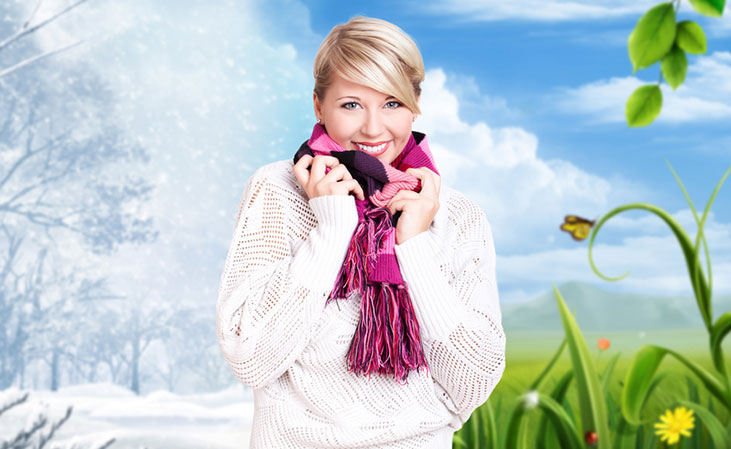Due to the strong temperature fluctuations during the transition period from winter to summer, there may be different heating requirements in the household. Exactly then there is a danger of heating too much and harmful.
We give you the 5 most important tips to keep heating costs as low as possible during this phase and avoid mold . If you don’t feel like implementing all the tips, there is a solution for you. We’ll tell you at the end of the article.
Tip 1: Close all doors to unheated rooms!
Not every room in the house is used equally often. For example, you are much more likely to spend time in your bedroom than in the hobby room in the basement. Logical conclusion is usually that unused premises are heated less than used.
In addition, the rooms used are heated differently. In a bathroom, a temperature of 23-24 degrees Celsius is considered comfortable. In the bedroom, on the other hand, 18 degrees Celsius is often enough to make you feel comfortable.
To prevent the unused or generally cooler rooms from giving off cold to the other rooms in the house, it’s best to close all doors to these rooms.
Tip 2: Take the weather into account!
Some days in the transitional season, you’ll have little to no need to heat because of the sun’s warmth. However, the sun’s rays do not always reach all the rooms of the house. Some continue to remain cool in response.
Caution is also advised when it comes to the issue of mold. Cold wall surfaces are prone to mold growth. Also for this reason, you should make sure that all rooms have the right basic temperature of at least 15 degrees Celsius.
Tip 3: Don’t turn off your heating too early!
No sooner are the warm days finally here again than the heaters are often hastily switched off. This has the disadvantage that the heating output must be turned up to full again on cold days. The result is high energy consumption, combined with comparatively high heating costs.
It is recommended to lower the heating a bit first, until it can be turned off completely afterwards in the summer months.
Tip 4: Ventilate as briefly as possible when the outside temperature is warm!
The warmer the outside temperatures become, the higher the humidity content. Moisture enters your premises with every airing.
On the other hand, when the outside temperature is colder, you can prolong your airing. In doing so, you can reduce the humidity in the house.
In terms of heating costs, it is important that you do not leave the window in the tilt position permanently. A 10 to 15-minute shock ventilation has the same effect, but saves energy.
Tip 5: Keep the heat in the house!
Since the days are usually warm in the transitional period, it is important to keep the heat in the house when it gets cold in the evening. The premises warm up mainly due to the radiant heat of the sun.
To prevent the heat gained from escaping back outside, you should close the windows with shutters and curtains after dark. This way you achieve an insulating effect and you also prevent cold air from getting inside from the outside.
Surface heating is the alternative solution for the transitional period
If you want to save yourself the trouble of implementing these tips, there is an alternative: panel heaters! They do not heat the air, but warm the matter (people, furniture, etc.) via radiant heat. This special heat acts like the sun.If you want to learn more about radiant heat, click here.
With panel heating installed on the floor, wall and/or ceiling, you can kill several birds with one stone at the same time:
- The heat can not escape from the house, because panel heating works via radiant heat!
- You can leave all the doors open in the house, because it is the matter that is heated!
- The panel heating ensures that the wall surface always shows a temperature of about 23 degrees Celsius. With it you feel comfortable in any weather and any season.
- Mold has no chance, because it always requires two conditions: high humidity and a cold surface. Due to the large-area heating, the surfaces are always well tempered.
- You can ventilate as much as you want without losing energy. You don’t have to, though, because high moisture content is no longer a problem.
Due to the low system temperature, heating costs are lower than with alternative heating systems.
Basically, the larger the heated area, the lower the system temperatures and thus the heating costs.
Conclusion: Efficient and healthy is very easy!
Whether you’re using these tips or thinking about replacing your heater, proper heating is easy.
You want to follow the tips? With a few steps you can reduce your energy consumption during the transition period. Internalize the few to-dos and make it a habit.
Thinking about replacing your heating system? Surface heating is not only energy-saving in the transitional period, but also healthy and environmentally friendly throughout the year. In the meantime, there are even some systems on the market that can be retrofitted very easily.
So in the future you no longer have to worry about high heating costs, but can already enjoy the first rays of sunshine?
Our panel heating is year-round, energy efficient, and doesn’t give mold a chance. If you also want to benefit from energy-saving and mold-repellent panel heating, click here.
Yes, I would like to benefit from energy-saving and mold-repellent panel heating.
Photo: fotogestoeber – fotolia.com



